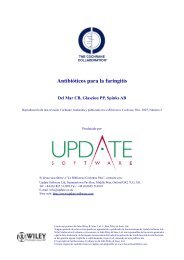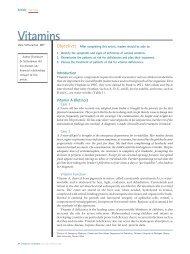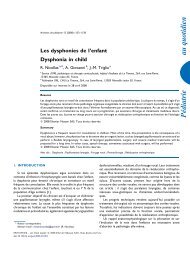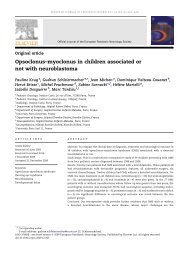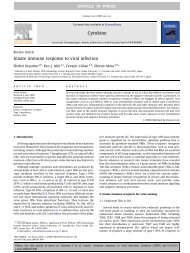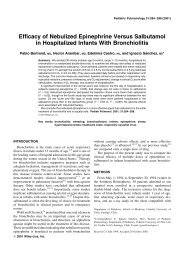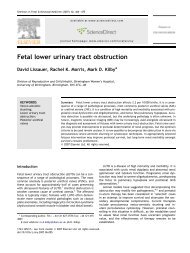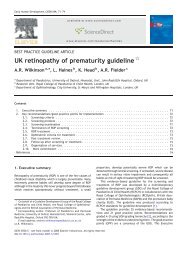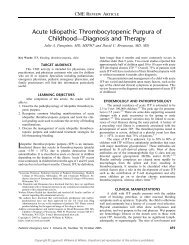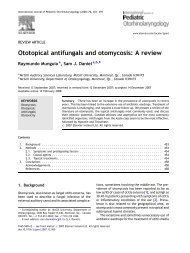Mini Review - sepeap
Mini Review - sepeap
Mini Review - sepeap
You also want an ePaper? Increase the reach of your titles
YUMPU automatically turns print PDFs into web optimized ePapers that Google loves.
J Pediatr Adolesc Gynecol (2007) 20:353e360<br />
<strong>Mini</strong> <strong>Review</strong><br />
Adrenarche and Polycystic Ovary Syndrome:<br />
A Tale of Two Hypotheses<br />
Shahla Nader, MD<br />
Departments of Internal Medicine (Endocrinology) and Obstetrics and Gynecology, University of Texas Medical School:<br />
Houston, Houston, Texas, USA<br />
Abstract. Polycystic ovary syndrome (PCOS) is an<br />
extremely common endocrine disorder affecting young<br />
women, with the potential for both reproductive and nonreproductive<br />
adverse outcomes. While oligomenorrhea,<br />
hyperandrogenism, and cystic ovarian morphology are recognized<br />
characteristics of this syndrome, the origin of these<br />
disturbances is not always apparent. During normal growth<br />
and development, adrenarche, the prepubertal onset of adrenal<br />
androgen secretion, results phenotypically in pubarche.<br />
Gonadarche, which is the ovarian response to gonadotropin<br />
releasing hormone-mediated gonadotropin secretion, also<br />
occurs, leading to reproductive competence, namely the<br />
establishment of ovulatory cycles, repeatedly. In this<br />
mini-review, an overview of adrenarche and gonadarche<br />
are presented, followed by two hypotheses. The first describes<br />
an evolutionary role for adrenarche: an advantage<br />
in the attainment of reproductive competence. The second<br />
proposes that the path to PCOS be viewed from a developmental<br />
perspective, namely, that PCOS is a maladaptation<br />
of the processes that lead to reproductive competence in<br />
women. Its defining characteristics of oligomenorrhea,<br />
hyperandrogenism, and cystic ovarian morphology are the<br />
final common pathway of multiple possible derangements.<br />
Elucidating and understanding these maladaptive processes<br />
will be the key to future endeavors at prevention and treatment<br />
of this common reproductive disorder.<br />
Key Words. Adrenarche—Gonadarche—Hyperandrogenism—Oligomenorrhea—Ovarian<br />
cysts<br />
Introduction<br />
While it is over 70 years since Stein and Levanthal 1<br />
described the association of amenorrhea, hirsutism,<br />
Address correspondence to: Shahla Nader, 6431 Fannin Street, Suite<br />
3604, Houston, Texas, 77030; E-mail: Shahla.Nader-Eftekhari@<br />
uth.tmc.edu<br />
Ó 2007 North American Society for Pediatric and Adolescent Gynecology<br />
Published by Elsevier Inc.<br />
and enlarged cystic ovaries, polycystic ovary syndrome<br />
(PCOS), as it is now called, remains one of<br />
the enigmas of reproductive endocrinology. 2,3 It is an<br />
extremely common disorder, affecting approximately<br />
6% of reproductive age women. 4 In addition, its recognized<br />
association, over the last few decades, with<br />
insulin resistance and the metabolic syndrome, 5 has<br />
added urgency to the quest for its genetic and pathogenic<br />
underpinnings. Remarkably, the discovery of its<br />
pediatric antecedents including premature pubarche<br />
and small for gestational age 6e8 have made this<br />
syndrome a holy grail for both pediatric and adult<br />
endocrinologists.<br />
As is well-known, the clinical manifestations<br />
include oligomenorrhea and oligo-ovulation, often<br />
dating from menarche, signs and symptoms of androgen<br />
excess, such as hirsutism, acne, oily skin and<br />
alopecia and many, but not all patients, also complain<br />
of obesity. While not part of the definition (and further<br />
discussed below), features of insulin resistance, such<br />
as acanthosis nigricans and skin tags, are often present<br />
and the obesity is usually abdominal, itself associated<br />
with insulin resistance. 2 Pathologically, the ovaries<br />
are often enlarged with a thickened capsule and hyperplastic<br />
stroma and contain multiple subcortical<br />
cysts, arranged in rosary-like fashion, some of which<br />
may enlarge and rupture, causing pain. Biochemically,<br />
ovarian or adrenal androgen excess, or both,<br />
may be demonstrated; there may be increased serum<br />
luteinizing hormone (LH) with low-normal follicle<br />
stimulating hormone (FSH), hence the high LH/FSH<br />
ratio, which is classic for this syndrome. In addition,<br />
serum sex-hormone binding globulin concentrations<br />
(SHBG) are low, and hence the high free androgens.<br />
The low SHBG may in part result from the excess<br />
androgens themselves but, more importantly, it relates<br />
to the insulin resistance commonly observed in these<br />
individuals. Biochemical features of insulin resistance<br />
may also be found: these include increased fasting<br />
1083-3188/07/$22.00<br />
doi:10.1016/j.jpag.2007.05.001
354 Nader: Adrenarche And Polycystic Ovary Syndrome<br />
serum insulin, exaggerated insulin responses to glucose,<br />
low glucose to insulin ratios, and occasionally<br />
impaired fasting glucose or impaired glucose tolerance.<br />
Biochemical features may also include dyslipidemia,<br />
with high triglycerides and low HDL, and<br />
abnormal adipocytokine profiles, with excess markers<br />
of inflammation. 2 While the clinical and/or biochemical<br />
features of insulin resistance are very commonly<br />
observed, not all patients with PCOS are obese or<br />
significantly resistant to insulin. 3<br />
For the most part the patients pose little diagnostic<br />
challenge; there is, however, some variability in the<br />
clinical, pathologic and biochemical findings and it<br />
has proven hard to actually define the syndrome.<br />
The 1990 National Institutes of Health consensus criteria<br />
required oligo-ovulation and androgen excess. A<br />
subsequent consensus conference, held in Rotterdam<br />
in 2003, defined the syndrome as two of the following<br />
three features: oligo-ovulation, clinical or biochemical<br />
evidence of androgen excess and multicystic ovaries. 9<br />
It also required exclusion of late-onset congenital adrenal<br />
hyperplasia, Cushing’s syndrome, other causes<br />
of androgen excess and hyperprolactinemia. Since<br />
its publication, there have been conflicts of opinion regarding<br />
this definition: some have supported it<br />
while others believe that hyperandrogenism should<br />
be an integral part of the definition of this syndrome.<br />
10 These criteria and viewpoints are summarized<br />
by Azziz et al, 11 who presented a position<br />
statement from the Androgen Excess Society, stating<br />
the relevance and importance of hyperandrogenism<br />
in the syndrome.<br />
We present, both a review and a viewpoint, a broader<br />
and developmental view of PCOS is presented, one<br />
encompassing multiple possible derangements. The<br />
processes leading to reproductive competence are<br />
briefly reviewed and two hypotheses are presented.<br />
The first relates to adrenarche and proposes a role<br />
for this developmental process in the attainment of reproductive<br />
competence. The second concerns PCOS<br />
and suggests that this syndrome is a maladaptation<br />
of the events that lead to reproductive competence<br />
in women.<br />
Reproductive Competence<br />
During fetal life, differentiation of the gonads into<br />
ovaries and testes is directed by the sex chromosome<br />
complement of the fetus and the hypothalamic-pituitary-gonadal<br />
(H-P-G) axis becomes functional in utero.<br />
12 After the neonatal period, the H-P-G axis is<br />
suppressed and remains so until the onset of gonadarche,<br />
which is manifest as pulsatile release of<br />
gonadotropin secretion, initially nocturnal. The precise<br />
mechanisms leading to disinhibition of gonadotropin<br />
releasing hormone (GnRH) production, and<br />
subsequent gonadotropin secretion, remain unknown<br />
but include removal of central inhibition, by gammaaminobutyric<br />
acid and possibly other neurotransmitters,<br />
12 and as puberty advances, a reduction in sex<br />
steroid inhibition of GnRH, 13,14 as will be discussed<br />
in a separate section. Release of GnRH allows secretion<br />
of the gonadotropins, LH and FSH, leading to<br />
ovarian secretion of testosterone and estradiol. Menarche<br />
heralds estrogenization of the endometrium sufficient<br />
to lead to withdrawal bleeding. Following<br />
menarche, ovulatory cycles are not immediately<br />
established. A longitudinal study showed that within<br />
one and three years of menarche, 10 or more cycles<br />
per 12 months occur in 65% and 90% of adolescents<br />
respectively. 15 These percentages may overestimate<br />
ovulatory cycles, because progesterone concentrations<br />
were not determined in the study.<br />
The GnRH pulse generator appears to have an<br />
intrinsic maximum firing frequency of one pulse per<br />
hour after puberty. 16 The frequency of these pulses<br />
determines which gonadotropin is preferentially<br />
synthesized, rapid pulses favoring LH and slower<br />
favoring FSH. 17 During each ovulatory menstrual<br />
cycle, follicular growth and ovarian steroidogenesis<br />
are stimulated by LH and FSH: while a small amount<br />
of LH can lead to sufficient androgen secretion (precursors<br />
of estradiol), a finite, threshold concentration<br />
of FSH is required for aromatization of androgens<br />
(to estradiol) and growth of a mature Graafian follicle.<br />
In the late follicular phase, sustained estradiol production,<br />
through positive feedback, leads to massive pituitary<br />
LH release, that is, to the mid-cycle LH<br />
surge. 1e20 The surge is followed by rupture of the<br />
follicle and formation of the corpus luteum, which<br />
produces progesterone. Progesterone not only prepares<br />
the uterus for pregnancy, but slows the GnRH<br />
pulse frequency from one pulse per hour to one every<br />
3e4 hours, 16 resulting in preferential synthesis of<br />
FSH in late luteal phase, peaking at menses and remaining<br />
high during the early follicular phase of the<br />
next cycle. This rise in FSH, called the FSH window,<br />
allows the next wave of follicular development and<br />
dominant follicle selection to occur. 20 Demise of the<br />
corpus luteum leads to shedding of the endometrium,<br />
marking the beginning of a new cycle. In women, full<br />
reproductive competence is achieved with the establishment<br />
of ovulatory cycles, occurring repeatedly.<br />
Adrenarche<br />
After birth the fetal zone of the adrenal gland<br />
involutes and there is a paucity of cells resembling zona<br />
reticularis. 21 This involution is accompanied by<br />
a rapid decline in dehydroepiandrosterone (DHEA)<br />
and dehydroepiandrosterone sulfate (DHEA-S).<br />
While in preadrenarcheal children only focal islands
Nader: Adrenarche And Polycystic Ovary Syndrome<br />
355<br />
of zona reticularis can be seen, with adrenarche there<br />
is an increase in size of the inner cortical zone, corresponding<br />
to increased steroidogenesis. 22 Adrenarche<br />
is the prepubertal onset of increased adrenal secretion<br />
of 19-carbon steroids, especially DHEA, DHEA-S,<br />
and androstenedione and occurs in children at about<br />
age 6e8 years. 23 The phenotypic outcome is pubarche,<br />
the development of pubic and axillary hair,<br />
and this occurs at or after age eight in girls. Serum<br />
DHEA and DHEA-S continue to rise in childhood,<br />
peaking at age 25e30, followed by slow decline.<br />
These C-19 steroids can be converted to testosterone<br />
and are called adrenal androgens.<br />
The proximal cause of adrenarche is not known<br />
with certainty. It has been suggested that the developmentally<br />
timed trigger for adrenarche, and its later<br />
decline at andropause, may be insulin-like growth factor-1(IGF-1).<br />
24 Prolactin has also been suggested as<br />
a trigger for adrenarche. 25 Interestingly, children with<br />
isolated growth hormone deficiency 26,27 and Laron<br />
dwarfism 28 may have delayed pubertal development,<br />
thus supporting a role for IGF-1 in the trigger of adrenarche.<br />
Insufficient adrenarche has also been reported<br />
in patients with PROP-1 gene defects, who have combined<br />
pituitary hormone deficiencies affecting gonadotropins,<br />
growth hormone, prolactin and TSH, again<br />
supporting roles for IGF-1 and possibly prolactin as<br />
initiators of adrenarche. 25,29 Conversely, precocious<br />
adrenarche has been demonstrated in pituitary gigantism<br />
with increased growth hormone and prolactin<br />
secretion. 30 Adrenarche represents an induction of<br />
17, 20 lyase and a decrease in 3-b hydroxysteroid<br />
dehydrogenase activity in the zona reticularis. 31,32<br />
Serine phosphorylation of P450c17 and access to<br />
cytochrome b5 as a co-factor appear to be necessary<br />
steps in this process. 33<br />
No adequate animal model exists for adrenarche;<br />
only chimpanzees and gorillas show a pattern of<br />
DHEA and DHEA-S characteristic of human adrenarche.<br />
The role of adrenarche in human physiology<br />
is unknown. 23,24 Neither the gonads nor gonadotropins<br />
are required for its onset. A study of 39 patients<br />
with gonadal dysgenesis showed age appropriate<br />
DHEA-S concentrations. 34 Conversely, gonadarche<br />
does not absolutely require the presence of the adrenals.<br />
27 It has been suggested that adrenarche is an<br />
example of ongoing evolution and that the failure to<br />
identify a clear DHEA deficiency state may indicate<br />
that higher primates have not yet evolved efficient<br />
ways of using this special hormonal environment. 24<br />
Hypothesis One: A Role for Adrenarche<br />
Boyar et al, 35 Sizenko and Paunier, 36 and Ducharme<br />
et al 37 have previously suggested that adrenarche<br />
may play a role in the maturation of the H-P-G axis.<br />
The hypothesis presented in the present paper proposes<br />
that adrenarche is a harbinger or promoter of<br />
gonadarche, an evolutionary safeguard, ensuring that<br />
gonadarche occurs earlier and perhaps with greater<br />
certainty than it would otherwise. There is clinical evidence<br />
to support this hypothesis. In a study of six<br />
girls with Addison’s disease before full pubertal maturation,<br />
breast development occurred at age 13.2 with<br />
menarche at 15.3 in one; menarche occurred at age 15<br />
in another, a third was prepubertal at 11.4, and two<br />
had menarche at ages 12.3 and 13 years. 38 The sixth<br />
patient had not menstruated by age 16.3, but she demonstrated<br />
both adrenal and theca cell antibodies and<br />
had a high FSH, indicative of concomitant ovarian<br />
failure. In the same study there were eight boys with<br />
a diagnosis of Addison’s; two started puberty at ages<br />
16.2, and 16, another was prepubertal at age 10.9, and<br />
four reached pubertal maturity between ages 14e16.<br />
One boy with both adrenal and Leydig cell antibodies<br />
was prepubertal at age 12.9. Two of the boys were<br />
already older than 13 at the time of diagnosis. In<br />
another study of seven males with Addison’s disease<br />
diagnosed at ages !1 to 11.8 years, onset of puberty,<br />
as determined by testicular enlargement O2.4 cm, occurred<br />
between 12.2 and 14.9 years as compared with<br />
age 11.40.4 for normal American boys. 39 The authors<br />
had concluded that the age of onset of gonadal<br />
pubertal development was no different in Addisonian<br />
patients but they had excluded from analysis two<br />
patients with pubertal onset at 14.3 and 14.9 years<br />
because the patients exhibited other autoimmune<br />
disease (alopecia and hypoparathyroidism) before<br />
the onset of puberty. Whether this was a valid reason<br />
for exclusion is open to debate.<br />
In parallel, lower adrenal androgens have been<br />
shown in male patients with constitutionally delayed<br />
puberty. 40 In a landmark study of children with pubertal<br />
disorders, 29 of 32 patients with constitutionally delayed<br />
growth and adolescence had significantly lower<br />
DHEA-S concentrations for their chronological age<br />
but appropriate for their bone age. 34 While this paper<br />
is often quoted to show evidence for the dissociation between<br />
adrenarche and gonadarche, as the authors themselves<br />
state, ‘‘patients with constitutionally delayed<br />
growth and adolescence often exhibit a delay in both<br />
adrenarche and gonadarche.’’ It is thus possible that<br />
delayed or inadequate adrenarche is the proximal cause<br />
of constitutionally delayed puberty and this may have<br />
a genetic basis. 41 In support of this possibility, earlier<br />
progression into gonadarche has been shown when<br />
males with constitutional delay were given androgens. 42<br />
Conversely, premature adrenarche has been linked<br />
with premature gonadal development, for example, as<br />
evidenced in patients with congenital adrenal hyperplasia.<br />
35 These authors showed that two boys with congenital<br />
adrenal hyperplasia, as well as manifesting
356 Nader: Adrenarche And Polycystic Ovary Syndrome<br />
advanced bone age, had augmented LH (and also FSH<br />
in one of the boys) during sleep at ages 8.5 and 5.5<br />
years. In the same landmark study 34 quoted above,<br />
there were nine females with idiopathic sexual precocity<br />
with onset between the ages of 6e8 years. All had<br />
Tanner stage 2e3 pubic hair, six had Tanner stage 3<br />
and three Tanner stage 2 breasts. These nine had advanced<br />
bone age and significantly greater DHEA-S<br />
concentrations than chronologic-age-matched controls;<br />
these concentrations were similar to those of normal<br />
children matched for bone age. As written by Sklar<br />
et al., 34 ‘‘These patients exhibited appropriate concordance<br />
between adrenal androgen and gonadal steroid<br />
concentrations. At least some of the patients with onset<br />
of idiopathic precocious puberty between 6 and 8 yr of<br />
age may represent one end of the normal spectrum of<br />
puberty development, their precocious puberty being<br />
part of a more generalized process which includes precocious<br />
activation of both gonadarche and adrenarche.’’<br />
The association between premature pubarche, as<br />
a result of early or amplified adrenarche, and early<br />
menarche was clearly demonstrated in a longitudinal<br />
study of 187 girls with premature pubarche. 43 The authors<br />
showed that menarche before age 12 was twofold<br />
more prevalent in these girls than in normal<br />
controls and was threefold more prevalent in a group<br />
of girls with both premature pubarche and low birth<br />
weight. Thus, while adrenarche and gonadarche can<br />
occur independently, are controlled and initiated by<br />
separate mechanisms, and have separate pathways, 44<br />
there appears to be a temporal link between adrenarche<br />
and gonadarche: early adrenarche is associated<br />
with earlier gonadarche and conversely delayed or<br />
inadequate adrenarche with later gonadarche.<br />
The biochemical evidence supporting a role for<br />
adrenarche in the onset of gonadarche, that is, a role<br />
for androgens in the establishment of gonadal axis<br />
maturation, is circumstantial. The progression of<br />
changes in neuroendocrine function in normal puberty<br />
will first be briefly discussed. This topic was elegantly<br />
reviewed by Blank et al. 45 They stated that the juvenile<br />
period of childhood is characterized by low levels<br />
of LH and FSH with approximately one pulse of<br />
GnRH every 4e6 hours. With the onset of puberty,<br />
nocturnal sleep-associated increases in LH pulse<br />
amplitude and frequency occur and precede pubertal<br />
maturation by about two years. LH pulse frequency<br />
and amplitude increases four- and nine-fold across pubertal<br />
maturation in girls. These nocturnal increases<br />
in LH lead to early morning increase in estradiol, progesterone<br />
and testosterone. 46,47 It has been proposed<br />
that, over time, the morning increases in progesterone<br />
contribute to the reduction in GnRH and LH pulsatility<br />
the following day, favoring FSH synthesis and thus<br />
follicular development, progesterone acting either directly<br />
or indirectly on the GnRH pulse generator. 47<br />
Androgens have been known to play a role in<br />
GnRH pulsatility. As previously stated, testosterone<br />
treatment of adolescent boys with constitutional delay<br />
has been shown to increase the tempo of testicular enlargement,<br />
as compared with control subjects. 42 This<br />
earlier gonadarche can only relate to central axis activation.<br />
In addition, it has long been known that<br />
women with PCOS require higher concentrations of<br />
progesterone to achieve the same degree of suppression<br />
of GnRH pulsatility as normal ovulatory control<br />
subjects. 48 This sensitivity is restored by the antiandrogen<br />
flutamide, implying that decreased progesterone<br />
sensitivity is secondary to hyperandrogenemia. 49<br />
Stated differently, androgens seem to be associated<br />
with a disinhibition of GnRH, with increased GnRH<br />
pulsatility, this also being a marker of the onset of gonadarche.<br />
In light of these observations, it is quite<br />
possible that the gradual increase in androgens characteristic<br />
of normal puberty 50 could potentially mediate<br />
this reduction of feedback sensitivity, leading to<br />
increased GnRH pulsatility, as was suggested by<br />
Blank et al. 45 In support of this possibility, Blank<br />
and colleagues performed a study on normal adolescent<br />
girls given estradiol and progesterone and<br />
showed that hypothalamic progesterone sensitivity<br />
(the ability of progesterone to inhibit GnRH pulsatility)<br />
decreases as puberty progresses, this being coincident<br />
with a rise in serum testosterone. They also<br />
showed that hypothalamic progesterone sensitivity is<br />
further reduced in adolescent girls with androgen<br />
excess (presented at the 88 th annual meeting of the<br />
Endocrine Society, Boston, June 2006, p 2-622).<br />
The hypothesis proposed there is that adrenarche,<br />
which precedes gonadarche, provides the initial<br />
source of androgens, leading to the disinhibition of<br />
GnRH, and hence gonadarche. The progression of<br />
the gonadal events of puberty, as outlined in the section<br />
on reproductive competence, and also above,<br />
would thus naturally follow the production of androgens<br />
at adrenarche, a harbinger of gonadarche. In<br />
the absence of adrenarche, as in patients with<br />
Addison’s disease for example, one would have to<br />
assume that other mechanisms such as the accrual<br />
of body fat and leptin activate the hypothalamic pulse<br />
generator, albeit later. 51,52<br />
Transition from Adrenarche to Full Reproductive<br />
Competence<br />
As outlined in the sections on reproductive competence<br />
and adrenarche, normal pubertal development starts<br />
with adrenarche and ends with the attainment of full reproductive<br />
competence, that is, persistent ovulation, in<br />
women. In the early phase of puberty, there is relative<br />
hyperandrogenism, with high levels of androgens relative<br />
to estrogens, as demonstrated in a study of 56
Nader: Adrenarche And Polycystic Ovary Syndrome<br />
357<br />
healthy girls from prepuberty to postmenarche. As Ankarberg<br />
and Norjavaara stated, ‘‘gonadarche in its earliest<br />
phase starts in an androgen-dominated state.’’ 50<br />
There is also increased LH to FSH ratio, with LH hyperpulsatility<br />
53,54 and a decrease in insulin sensitivity with<br />
increased insulin secretion. 55,56 Thus, during pubertal<br />
development, that is, in the transition leading to the attainment<br />
of full reproductive competence, adolescent<br />
females have relative androgenemia, insulin resistance,<br />
and predominantly anovulatory cycles. During this interval,<br />
ovarian morphology studies, as determined by<br />
ultrasound, have also shown cystic ovaries. Orsini et<br />
al 57 studied the ovaries of 114 premenarcheal girls<br />
and found cystic functional changes after age five. Cohen<br />
et al 58 determined the prevalence of ovarian cysts in<br />
101 premenarcheal girls aged 2e12 years. Cysts were<br />
identified in 68% of ovaries scanned, including a few<br />
cysts O9mm. Similarly, Buzi et al 59 showed that multicystic<br />
ovaries, defined as containing $6 follicles with<br />
diameters 4e9mm, occurred after age 7 in normal girls.<br />
Using the 1990 National Institutes of Health consensus<br />
criteria, components of the 2003 Rotterdam<br />
criteria, 9,10 or the latest criteria from the Androgen<br />
Excess Society 11 for the definition of PCOS, it<br />
becomes evident that the transition from adrenarche<br />
to full reproductive competence is a PCOS-like state.<br />
So, if pubertal development is PCOS-like in its<br />
characteristics, then what is PCOS?<br />
Hypothesis Two: PCOS Is a Developmental<br />
Maladaptation<br />
What we recognize as PCOS, namely, persistent anovulation,<br />
hyperandrogenism, and PCO morphology is<br />
a maladaptation of the evolutionary phenomenon that<br />
is adrenarche. In essence, PCOS is when the PCOSlike<br />
state of the pubertal transition cannot be turned<br />
off or overcome, as was shown in a prospective study<br />
of adolescents. 60 This was also proposed by Ankarberg<br />
and Norjavaara, who stated, ‘‘It is an interesting<br />
hypothesis that PCOS may develop from abnormal<br />
pubertal development, and a critical point in pubertal<br />
development could be in the transition stage from the<br />
early pubertal androgen-dominated state to the estrogenic<br />
state later in puberty.’’ 50 In its effect, it is either<br />
a persistent adrenarche-like state with excess adrenal<br />
androgen production, 61 or a state of persistent hyperandrogenemia<br />
resulting from excess stimulation of the<br />
ovaries by LH and trophic stimuli such as insulin, or,<br />
it is a combination of the two.<br />
The path to PCOS is not a single one: numerous<br />
aberrations can result in this derangement. These<br />
pathways can be rare or common. They may be purely<br />
genetic, purely environmental, or a combination.<br />
They may even relate to programming during intrauterine<br />
life, resulting from a particular intrauterine<br />
environment. For example, numerous and sundry<br />
pathways associated with insulin resistance and hyperinsulinemia<br />
commonly lead to PCOS. Genetically<br />
mediated insulin resistance leads to hyperinsulinemia.<br />
This has a profound effect on androgen production because<br />
insulin is a trophic hormone that can stimulate<br />
both ovarian and adrenal androgen secretion. 62e64 Insulin<br />
resistance itself may be developmental in origin,<br />
in association with and subsequent to alterations in fuel<br />
metabolism, as in small-for-gestational-age babies who<br />
have rapid catch-up growth in infancy. 7,8,65,66 Alternatively,<br />
the insulin resistance may be secondary to environmental<br />
factors leading to obesity, especially in<br />
individuals with the thrifty genotype or a genetic predisposition<br />
to insulin resistance. For example, peripubertal<br />
obesity was shown to be a factor in the genesis<br />
of postpubertal hyperandrogenism 67 and reversibility<br />
has been demonstrated following weight loss. 68 Clinical<br />
manifestations of these insulin resistant subjects<br />
includes premature pubarche, early menarche, and<br />
adolescent or adult PCOS. 6,43<br />
However, as well as genes involved in insulin secretion<br />
and action, there may also be other genetic<br />
causes of aberrant androgen secretion leading to the<br />
PCOS phenotype: insulin resistance is not the initiating<br />
pathophysiology of all cases of PCOS. For example,<br />
genes involved in steroid metabolism and action<br />
and gonadotropin activity and regulation have been<br />
linked to PCOS. 69,70 Genetic variations 71e73 and rare<br />
disorders of steroidogenesis 74 may lead to the PCOS<br />
phenotype. Because androgens themselves are associated<br />
with insulin resistance, any hyperandrogenic<br />
individual may secondarily have decreased insulin<br />
sensitivity, as shown in female-to-male transsexuals,<br />
given androgens. 75 Similarly, puberty itself is a state<br />
of relative insulin insensitivity and hyperandrogenic<br />
adolescents may thus be insulin resistant. 76 Even prenatal<br />
androgen exposure of the female fetus can lead<br />
to subsequent PCOS, through potentially diverse pathways<br />
that include central fat accumulation (and insulin<br />
resistance), and altered target tissue differentiation,<br />
for example, differentiation of the hypothalamicpituitary<br />
axis or ovarian theca cells. 77<br />
Summary and Conclusions<br />
Adrenarche and PCOS are two sides of a coin representing<br />
evolutionary advantage (adrenarche) and maladaptation<br />
(PCOS). In populations that are threatened<br />
with starvation, disease, and malnutrition, adrenarche<br />
would be an advantage, promoting earlier gonadarche<br />
and ensuring survival of the species. Even today, there<br />
are many who are starving or malnourished. Nearly<br />
67 million children weigh less than they should for<br />
their height and 183 million weigh less than they<br />
should for their age, and the reproductive system is<br />
very sensitive to external influences. 78 In many
358 Nader: Adrenarche And Polycystic Ovary Syndrome<br />
animals, conception is timed to ensure that birth takes<br />
place in a season when food and climatic conditions<br />
are appropriate. 79 Women affected by the Dutch famine<br />
of 1944e45 at ages 3e13 years had a 1.9-fold<br />
higher risk of having fewer than the desired number<br />
of children in their lifetime. 80<br />
Unfortunately, in the western hemisphere, where<br />
the food supply is plentiful, there is maladaptation.<br />
This may be exacerbated by an adverse intrauterine<br />
environment followed by excess catch-up growth, by<br />
genetic insulin resistance, often compounded by obesity<br />
or by a thrifty genotype. 78 Under such circumstances,<br />
early and excessive production of androgens<br />
from the adrenals promotes growth, development,<br />
and bone maturation, and leads to excessive LHinduced<br />
ovarian androgen production. These events<br />
hasten gonadarche but hinder full gonadal maturation<br />
and the establishment of ovulatory cycles. This state<br />
of hyperandrogenism, anovulation, and cystic ovarian<br />
morphology is what we call PCOS.<br />
Challenges and Future Directions<br />
We need to move away from the concept of a single<br />
path to PCOS toward a broader view of its pathogenesis,<br />
encompassing multiple derangements. What we<br />
call PCOS is likely to be a diverse group of disorders<br />
with similar clinical manifestations and shared biochemical<br />
features. There will be commonalities and<br />
differences in these different entities. Should they<br />
all be called PCOS? For example, non-classic or<br />
late-onset congenital adrenal hyperplasia is really<br />
a form of PCOS, with clinical manifestations that are<br />
virtually identical. The partial deficiency of the 21-<br />
hydroxylase enzyme responsible for the commonest<br />
form of this disorder does not manifest itself clinically<br />
during early childhood. As the zona reticularis develops<br />
and is stimulated, excessive amounts of adrenal<br />
androgens are produced. 81 This androgen excess<br />
not only leads to hirsutism, but hinders the establishment<br />
of normal ovulatory cycles. We do not call it<br />
PCOS because we understand its pathophysiology<br />
and genetics and categorize it as a separate entity.<br />
Thus it would seem that our task should begin by<br />
cataloging androgen excess disorders, determining<br />
their associations, biochemical pathways, and genetics.<br />
Only by doing so can we rationally approach prevention<br />
and treatment of this common reproductive<br />
problem and its many consequences.<br />
References<br />
1. Stein IF, Levanthal M: Amenorrhea associated with bilateral<br />
polycystic ovaries. Am J Obstet Gynecol 1935; 29:181<br />
2. Ehrmann DA: Polycystic ovary syndrome. N Engl J Med<br />
2005; 352:1223<br />
3. Carmina E: The spectrum of androgen excess disorders.<br />
Fertil Steril 2006; 85:1582<br />
4. Diamanti-Kandarakis E, Kouli CR, Bergiele AT, et al: A<br />
survey of the polycystic ovary syndrome in the Greek island<br />
of Lesbos: hormonal and metabolic profiles. J Clin<br />
Endocrinol Metab 1999; 84:4006<br />
5. Sam S, Dunaif A: Polycystic ovary syndrome: syndrome<br />
XX? Trends Endocrinol Metab 2003; 14:365<br />
6. Ibanez L, Dimartino-Nardi J, Potau N, et al: Premature<br />
adrenarche-normal variant or forerunner of adult disease?<br />
Endocr Rev 2000; 21:671<br />
7. Ibanez L, Ong K, Dunger DB, et al: Early development of<br />
adiposity and insulin resistance after catch-up weight gain<br />
in small-for-gestational-age children. J Clin Endocrinol<br />
Metab 2006; 91:2153<br />
8. Ibanez L, Valls C, Ong K, et al: Metformin therapy during<br />
puberty delays menarche prolongs pubertal growth and<br />
augments adult height: A randomized trial of low-birthweight<br />
girls with early-normal onset of puberty. J Clin<br />
Endocrinol Metab 2006; 91:2068<br />
9. Rotterdam ESHRE/ASRM-sponsored PCOS consensus<br />
workshop group: Revised 2003 consensus on diagnostic<br />
criteria and long-term health risks related to polycystic<br />
ovary syndrome (PCOS). Hum Reprod 2004; 19:41<br />
10. Azziz R: Diagnostic criteria for polycystic ovary syndrome:<br />
A reappraisal. Fertil Steril 2005; 83:1343<br />
11. Azziz R, Camina A, Dewailly D, et al: Position statement:<br />
Criteria for defining polycystic ovary syndrome as a<br />
predominantly hyperandrogenic syndrome: An Androgen<br />
Excess Society Guideline. J Clin Endocrinol Metab 2006;<br />
91:4237<br />
12. Terasawa EI, Fernandez DL: Neurobiological mechanisms<br />
of the onset of puberty in primates. Endocr Rev 2001; 22:<br />
111<br />
13. Reiter EO, Grumbach MM: Neuroendocrine control mechanisms<br />
and the onset of puberty. Annu Rev Physiol 1982;<br />
44:595<br />
14. Rapisarda JJ, Bergman KS, Steiner RA, et al: Response to<br />
estradiol inhibition of tonic luteinizing hormone secretion<br />
decreases during the final stage of puberty in the rhesus<br />
monkey. Endocrinology 1983; 112:1172<br />
15. Legro RS, Lin HM, Demers LM, et al: Rapid maturation<br />
of the reproductive axis during perimenarche independent<br />
of body composition. J Clin Endocrinol Metab 2000; 85:<br />
1021<br />
16. Filicori M, Santoro N, Merriam GR, et al: Characterization<br />
of the physiologic pattern of episodic gonadotropin secretion<br />
throughout the human menstrual cycle. J Clin Endocrinol<br />
Metab 1986; 62:1136<br />
17. Gross KM, Matsumoto AM, Bremner WJ: Differential<br />
control of luteinizing hormone and follicle stimulating<br />
hormone secretion by luteinizing hormone releasing hormone<br />
pulse frequency in man. J Clin Endocrinol Metab<br />
1987; 64:675<br />
18. Hoff JD, Quigley ME, Yen SS: Hormonal dynamics at<br />
mid-cycle: a reevaluation. J Clin Endocrinol Metab<br />
1983; 57:792<br />
19. Adams JM, Taylor AE, Schoenfeld DA, et al: The midcycle<br />
gonadotropin surge in normal women occurs in the<br />
face of an unchanging gonadotropin-releasing hormone<br />
pulse frequency. J Clin Endocrinol Metab 1994; 79:858
Nader: Adrenarche And Polycystic Ovary Syndrome<br />
359<br />
20. Messinis IE: Ovarian feedback, mechanism of action and<br />
possible clinical implications. Hum Reprod Update 2006;<br />
12:557<br />
21. Bech K, Tygstrop I, Nerup J: The involution of the foetal<br />
adrenal cortex. A light microscopy study. Acta Pathol<br />
Microbiol Scand 1969; 76:391<br />
22. Havelock JC, Auchus RJ, Rainey WE: The rise in adrenal<br />
androgen biosynthesis: adrenarche. Sem Reprod Med<br />
2004; 22:337<br />
23. Arlt W, Martens JWM, Song M, et al: Molecular evolution of<br />
adrenarche: structural and functional analysis of P450c17<br />
from four primate species. Endocrinology 2002; 143:4665<br />
24. Miller WL: The molecular basis of premature adrenarche:<br />
an hypothesis. Acta Paediatr Suppl 1999; 443:60<br />
25. Taha D, Mullis PE, Ibanez L, et al: Absent or delayed adrenarche<br />
in Pit-1, POU1F1 deficiency. Horm Res 2005; 64:175<br />
26. Tanner J, Whitehouse R: A note on the bone age at which<br />
patients with true isolated growth hormone deficiency<br />
enter puberty. J Clin Endocrinol Metab 1975; 41:788<br />
27. Veldhuis JD, Roemmich JN, Richmond EJ, et al: Somatotropic<br />
and gonadotropic axes linkages in infancy, childhood<br />
and the puberty-adult transition. Endocr Rev 2006;<br />
27:101<br />
28. Laron Z, Sarel R, Pertzelan A: Puberty in Laron type<br />
dwarfism. Eur J Pediatr 1980; 134:79<br />
29. Voutetakis A, Livadas A, Sertedaki A, et al: Insufficient<br />
adrenarche in patients with combined pituitary hormone<br />
deficiency caused by PROP-1 gene defect. J Pediatr<br />
Endocrinol 2001; 14:1107<br />
30. Iwatani N, Kodama M, Seto H: A child with pituitary gigantism<br />
and precocious adrenarche: does growth hormone<br />
and prolactin advance the onset of adrenarche? Endocrinol<br />
Jpn 1992; 39:251<br />
31. Gell JS, Carr BR, Sasano H, et al: Adrenarche results from<br />
development of a 3-b hydroxysteroid dehydrogenase deficient<br />
adrenal reticularis. J Clin Endocrinol Metab 1998;<br />
83:3695<br />
32. Miller WL: <strong>Mini</strong>review: Regulation of steroidogenesis by<br />
electron transfer. Endocrinology 2005; 146:2544<br />
33. Pandey AV, Miller WL: Regulation of 17,20 lyase activity<br />
by cytochrome b5 and by serine phosphorylation of<br />
P450c17. J Biol Chem 2005; 280:13265<br />
34. Sklar CA, Kaplan SL, Grumbach MM: Evidence for dissociation<br />
between adrenarche and gonadarche: Studies in<br />
patients with idiopathic precocious puberty, gonadal dysgenesis,<br />
isolated gonadotropin deficiency and constitutionally<br />
delayed growth and adolescence. J Clin Endocrinol<br />
Metab 1980; 51:548<br />
35. Boyar RM, Finkelstein JW, David R, et al: Twenty-four<br />
hour patterns of plasma luteinizing hormone and follicle<br />
stimulating hormone in sexual precocity. N Engl J Med<br />
1973; 289:282<br />
36. Sizonenko PC, Paunier L: Hormonal changes in puberty<br />
III: Correlation of plasma dehydroepiandrosterone, testosterone,<br />
FSH, and LH with stages of puberty and bone age<br />
in normal boys and girls and I patients with Addison’s<br />
disease or hypogonadism or with premature or late adrenarche.<br />
J Clin Endocrinol Metab 1975; 41:894<br />
37. Ducharme JR, Forest MG, de Peretti E, et al: Plasma adrenal<br />
and gonadal sex steroids in human pubertal development.<br />
J Clin Endocrinol Metab 1976; 42:468<br />
38. Grant DB, Barnes ND, Moncrieff MW, et al: Clinical presentation,<br />
growth and pubertal development in Addison’s<br />
disease in childhood. Arch Dis Child 1985; 60:925<br />
39. Urban MD, Lee PA, Gutai JP, et al: Androgens in pubertal<br />
males with Addison’s disease. J Clin Endocrinol Metab<br />
1980; 51:925<br />
40. Copeland KC, Paunier L, Sizonenko PC: The secretion of<br />
adrenal androgens and growth patterns of patients with<br />
hypogonadotropic hypogonadism and isolated delayed<br />
puberty. J Pediatr 1977; 91:985<br />
41. Sedlmeyer IL, Hirschhorn JN, Palmert MR: Pedigree analysis<br />
of constitutional delay of growth and maturation:<br />
Determination of familial aggregation and inheritance<br />
patterns. J Clin Endocrinol Metab 2002; 87:5581<br />
42. Soliman AT, Khadir MM, Asfour M: Testosterone treatment<br />
in adolescent boys with constitutional delay in<br />
growth and development. Metabolism 1995; 44:1013<br />
43. Ibanez L, Jimenez R, de Zegher F: Early puberty-menarche<br />
after precocious pubarche: Relation to prenatal<br />
growth. Pediatrics 2006; 117:117<br />
44. Counts DR, Pescovitz OH, Barnes KM, et al: Dissociation<br />
of adrenarche and gonadarche in precocious puberty and in<br />
isolated hypogonadotropic hypogonadism. J Clin Endocrinol<br />
Metab 1987; 64:1174<br />
45. Blank SK, McCartney CR, Marshall JC: The origins and<br />
sequelae of abnormal neuroendocrine function in polycystic<br />
ovary syndrome. Hum Reprod Update 2006; 12:351<br />
46. Mitamura R, Yano K, Suzuki N, et al: Diurnal rhythms of<br />
luteinizing hormone, follicle stimulating hormone, testosterone<br />
and estradiol secretion before the onset of female<br />
puberty in short children. J Clin Endocrinol Metab 2000;<br />
85:1074<br />
47. McCartney CR, Blank SK, Prendergast KA, et al: Obesity<br />
and sex steroid changes across puberty: Evidence for<br />
marked hyperandrogenemia in pre- and early pubertal<br />
obese girls. J Clin Endocrinol Metab 2007; 92:430<br />
48. Pastor CL, Griffin-Korf ML, Aloi JA, et al: Polycystic<br />
ovary syndrome: evidence for reduced sensitivity of the<br />
gonadotropin releasing hormone pulse generator to inhibition<br />
by estradiol and progesterone. J Clin Endocrinol<br />
Metab 1998; 83:582<br />
49. Eagleson CA, Gingrich MB, Pastor CL, et al: Polycystic<br />
ovary syndrome: evidence that flutamide restores sensitivity<br />
of the gonadotropin releasing hormone pulse generator<br />
to inhibition by estradiol and progesterone. J Clin Endocrinol<br />
Metab 2000; 85:4047<br />
50. Ankarberg C, Norjavaara E: Diurnal rhythm of testosterone<br />
secretion before and throughout puberty in healthy<br />
girls: Correlation with 17b-estradiol and dehydroepiandrosterone<br />
sulfate. J Clin Endocrinol Metab 1999; 84:<br />
975<br />
51. Matkovic V, Illich JZ, Skugor M, et al: Leptin is inversely<br />
related to age at menarche in human females. J Clin Endocrinol<br />
Metab 1997; 82:3239<br />
52. Budak E, Sanchez MF, Bellver J, et al: Interactions of the<br />
hormones leptin, ghrelin, adiponectin, resistin and PYY3-<br />
36 with the reproductive system. Fertil Steril 2006; 85:<br />
1563<br />
53. Oerter KE, Uriarte MM, Rose SR, et al: Gonadotropin secretory<br />
dynamics during puberty in normal girls and boys.<br />
J Clin Endocrinol Metab 1990; 71:1251
360 Nader: Adrenarche And Polycystic Ovary Syndrome<br />
54. Apter D, Butzow T, Laughlin G, et al: Gonadotropin releasing<br />
hormone pulse generator activity during pubertal<br />
transition in girls: Pulsatile and diurnal patterns of circulating<br />
gonadtropins. J Clin Endocrinol Metab 1993; 76:940<br />
55. Bloch CA, Clemmons P, Sperling M: Pubertal decrease in<br />
insulin sensitivity. J Pediatr 1987; 110:481<br />
56. Smith CP, Dunger DB, Williams AKJ, et al: Relationship<br />
between insulin, insulin-like growth factor I, dehydroepiandrosterone<br />
sulfate concentrations during childhood, puberty<br />
and adult life. J Clin Endocrinol Metab 1989; 68:932<br />
57. Orsini L, Salardi S, Pilu G, et al: Pelvic organs in premenarcheal<br />
girls: real-time ultrasonography. Radiology 1984;<br />
153:113<br />
58. Cohen HL, Eisenberg P, Mandel F, et al: Ovarian cysts are<br />
common in premenarcheal girls: a sonographic study of<br />
101 children 2e12 years old. Am J Radiol 1992; 159:89<br />
59. Buzi F, Pilotta A, Dardoni D, et al: Pelvic ultrasonography<br />
in normal girls and in girls with precocious puberty. Acta<br />
Paediatr 1998; 87:1138<br />
60. Venturoli S, Porcu E, Fabbri R, et al: Longitudinal evaluation<br />
of the different gonadotropin pulsatile patterns in<br />
anovulatory cycles of young girls. J Clin Endocrinol<br />
Metab 1992; 74:836<br />
61. Kumar A, Woods KS, Bartolucci AA, et al: Prevalence of<br />
adrenal androgen excess in patients with polycystic ovary<br />
syndrome. Clin Endocrinol 2005; 62:644<br />
62. Dunaif A: Insulin resistance and the polycystic ovary syndrome.:<br />
Mechanisms and implications for pathogenesis.<br />
Endocr Rev 1997; 18:774<br />
63. Poretsky L, Cataldo NA, Rosenwaks Z, et al: The insulinrelated<br />
ovarian regulatory system in health and disease.<br />
Endocr Rev 1999; 20:535<br />
64. Vambergue A, Lautier C, Valat AS, et al: Follow-up study<br />
of two sisters with type A syndrome of severe insulin<br />
resistance gives a new insight into PCOS pathogenesis in<br />
relation to puberty and pregnancy outcome: a case report.<br />
Hum Reprod 2006; 21:1274<br />
65. Ibanez L, Potau N, Francois I, et al: Precocious pubarche,-<br />
hyperinsulinism, and ovarian hyperandrogenism in girls:<br />
relation to reduced fetal growth. J Clin Endocrinol Metab<br />
1998; 83:3558<br />
66. Hoffman PL, Regan F, Jackson WE, et al: Premature birth<br />
and later insulin resistance. N Engl J Med 2004; 351:2179<br />
67. McCartney CR, Prendergast KA, Chlabra S, et al: The<br />
association of obesity and hyperandrogenemia during the<br />
pubertal transition in girls: obesity as a potential factor<br />
in the genesis of postpubertal hyperandrogenism. J Clin<br />
Endocrinol Metab 2006; 91:1714<br />
68. Reinehr T, de Sousa G, Roth CL, et al: Androgens before<br />
and after weight loss in obese children. J Clin Endocrinol<br />
Metab 2005; 90:5588<br />
69. Diamanti-Kandarakis E, Piperi C: Genetics of polycystic<br />
ovary syndrome: searching for the way out of the labyrinth.<br />
Human Reprod Update 2005; 11:631<br />
70. Goodarzi MO: The genetic basis of the polycystic ovary<br />
syndrome. Androgen excess disorders in women: Polycystic<br />
ovary syndrome and other disorders. In: Azziz R,<br />
Nestler JE, Dewaillly D, editors. Totowa, Humana Press,<br />
2006, pp 223e233<br />
71. Lee PA, Migeon CJ, Bias WB, et al: Familial hypersecretion<br />
of adrenal androgens transmitted as a dominant,<br />
non-HLA linked trait. Obstet Gynecol 1987; 69:259<br />
72. Gambineri A, Vicennati V, Genghini S, et al: Genetic<br />
variation in 11 b-hydroxysteroid dehydrogenase type 1<br />
predicts adrenal hyperandrogenism among lean women<br />
with polycystic ovary syndrome. J Clin Endocrinol Metab<br />
2006; 91:2295<br />
73. Ghadir S, Azziz R: Reproducibility of the adrenal androgen<br />
response to adrenocorticotropic hormone stimulation.<br />
Fertil Steril 2006; 86:484<br />
74. Miller WL: Disorders of androgen synthesis- from cholesterol<br />
to dehydroepiandrosterone. Med Princ Pract 2005;<br />
14(suppl 1):58<br />
75. Polderman KH, Gooren LJ, Asscherman H, et al: Induction<br />
of insulin resistance by androgens and estrogens.<br />
J Clin Endocrinol Metab 1994; 79:265<br />
76. Moran A, Jacobs DR, Steinberger J, et al: Insulin resistance<br />
during puberty: results from clamp studies in 357<br />
children. Diabetes 1999; 48:2039<br />
77. Xita N, Tsatsoulis A: <strong>Review</strong>: Fetal programming of polycystic<br />
ovary syndrome by androgen excess: evidence from<br />
experimental, clinical genetic association studies. J Clin<br />
Endocrinol Metab 2006; 91:1660<br />
78. ESHRE Capri Workshop Group: Nutrition and reproduction<br />
in women. Hum Reprod Update 2006; 12:193<br />
79. Martin GB, Roger J, Blache D: Nutritional and environmental<br />
effects on reproduction in small ruminants. Reprod<br />
Fertil Dev 2004; 16:491<br />
80. Elias SJ, van Noord PAH, Peeters PHM, et al: Childhood<br />
exposure to the 1944e45 Dutch famine and subsequent female<br />
reproductive function. Hum Reprod 2005; 20:2483<br />
81. Dewailly D, Azziz R: The non-classic adrenal hyperplasias.<br />
In: Azziz R, Nestler JE, Dewaillly D, editors. Androgen<br />
excess disorders in women: Polycystic ovary<br />
syndrome and other disorders. Totowa, Humana Press,<br />
2006, pp 91e106




